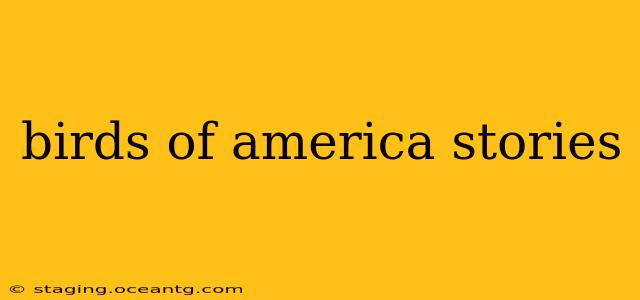The avian world, a kaleidoscope of color, song, and breathtaking flight, has captivated human imagination for millennia. From the soaring eagle to the tiny hummingbird, birds have inspired countless stories, myths, and legends across cultures and continents. This exploration delves into the rich tapestry of narratives woven around the birds of America, examining their symbolic significance, their roles in folklore, and the impact they've had on literature and art. We'll explore both the factual and the fantastical, revealing the enduring connection between humans and the birds that share our skies.
What are some famous stories about American birds?
Many American bird species have become ingrained in our cultural narratives. The bald eagle, a potent symbol of national pride, features prominently in American folklore and literature, often representing freedom, strength, and majesty. Similarly, the iconic stories of the mockingbird, with its exceptional mimicry and spirited nature, frequently explore themes of resilience and adaptation. Native American cultures, too, hold deep connections with various birds, integrating them into creation myths and spiritual beliefs, often assigning symbolic meanings based on the bird's unique characteristics. For example, the raven might represent wisdom or magic, while the hummingbird might symbolize agility and quickness. Each species carries its own weight of stories, passed down through generations.
What are some Native American legends about birds?
Indigenous American cultures have a rich oral tradition filled with compelling narratives featuring birds. These stories often serve as explanations for natural phenomena, teach moral lessons, or recount historical events. Legends vary widely across different tribes and nations, but common themes involve birds acting as messengers, guides, or protectors. Some stories portray birds as shapeshifters, capable of transforming into human form or possessing supernatural powers. These myths are not just entertaining tales; they reflect a deep understanding of the natural world and a profound respect for the creatures within it. Understanding these legends offers a glimpse into the unique worldview of these cultures and their interconnectedness with the avian world.
Are there any children's books about American birds?
The vibrant world of American birds has inspired countless children's books, often designed to educate and entertain young readers. These books frequently incorporate colorful illustrations, engaging storylines, and age-appropriate information about different bird species. Many focus on a specific bird, highlighting its unique habits, habitat, and place within the ecosystem. Others offer broader overviews of American birdlife, introducing children to a diverse range of species and encouraging a love for nature and conservation. These books play a crucial role in fostering an appreciation for birds from a young age, encouraging future generations to protect and understand these remarkable creatures.
How have birds influenced American art and literature?
Birds have served as both subject and symbol in American art and literature, inspiring countless works across various genres. From the realistic depictions of Audubon's "Birds of America" to the symbolic use of birds in poetry and prose, their presence reflects a deep and enduring connection between humans and the avian world. The soaring flight of birds often symbolizes freedom and aspiration, while their songs can evoke emotions ranging from joy to melancholy. The diverse plumage and behaviors of American birds have provided rich inspiration for artists and writers alike, resulting in a vast body of work that captures the beauty and mystery of these creatures. This artistic representation has, in turn, played a role in shaping cultural perceptions and promoting awareness of avian conservation.
What role do birds play in American folklore?
Birds play significant roles in American folklore, often appearing as messengers, omens, or symbols of specific qualities. Many tales relate how particular birds' calls or appearances could predict upcoming events, good or bad. Folklore traditions frequently connect birds with weather patterns, agricultural cycles, or other natural phenomena. These stories were often passed down through generations, serving both as entertaining narratives and as practical guides for interpreting the natural world. By studying these folk traditions, we can gain insight into the historical relationship between humans and the avian world, recognizing the role birds played in shaping cultural beliefs and practices.
This exploration only scratches the surface of the numerous stories interwoven with the lives of birds across America. From ancient myths to modern children's literature, the feathered inhabitants of our continent continue to inspire awe, wonder, and a deep appreciation for the natural world. As we continue to learn more about these amazing creatures, the stories surrounding them will undoubtedly continue to evolve and enrich our understanding of both the avian world and ourselves.
